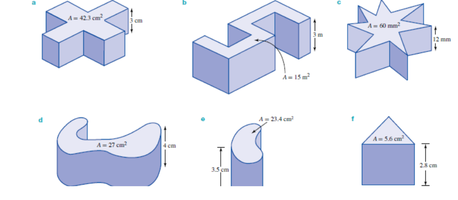You are using an out of date browser. It may not display this or other websites correctly.
You should upgrade or use an alternative browser.
You should upgrade or use an alternative browser.
Finding the Volume of odd shapes (given cross-sectional area and height)
- Thread starter joshdal9
- Start date
Dr.Peterson
Elite Member
- Joined
- Nov 12, 2017
- Messages
- 16,863
There are all examples of generalized prisms or cylinders, and there is a simple formula for the volume, given exactly the data you are given here.Hi I am struggling to find the volume of these odd shapes.
I know how to find the volume when its a whole but want to know how to take the gap away.
Thanks.
What do you mean by "whole" and "gap"?
- Joined
- Feb 4, 2004
- Messages
- 16,550
You've been given the cross-sectional area for each shape, along with its height. What did your book and instructor do for this sort of thing? Follow the exact same step (and it is only one step).Hi I am struggling to find the volume of these odd shapes.
I know how to find the volume when its a whole but want to know how to take the gap away.
Thanks.
For that to be true, the solid in question must be a "right (perpendicular) prism".Multiply the base by the height
The Highlander
Senior Member
- Joined
- Feb 18, 2022
- Messages
- 1,195
For the avoidance of any doubt...Hi I am struggling to find the volume of these odd shapes.
I know how to find the volume when its a whole but want to know how to take the gap away.
Thanks.
When @Steven G says "Multiply the base by the height" that is the correct formula for the volume of a solid when the cross-sectional area remains the same all the way up from the base to the top, ie: it is a Prism (or Right Prism as @khansaheb points out).
You, of course, are not given any information about the "base" of these solids but, for it to be possible to answer the questions (as presented), you must assume that the cross-sectional area of each solid does remain the same all the way down from the top to the bottom.
Hence you just want: Area at the Top × the Height.
Hope that helps. ?
Dr.Peterson
Elite Member
- Joined
- Nov 12, 2017
- Messages
- 16,863
Actually, that applies even to oblique prisms or cylinders, as long as the "height" is measured perpendicular to the base.For that to be true, the solid in question must be a "right (perpendicular) prism".
My objection to the statement is merely that "base" is somewhat ambiguous; here it means base area.
And, of course, definitions vary a lot as to whether these are all prisms (even those whose bases are not polygons), or are all cylinders (even those with polygonal bases). Both mean that all cross-sections are congruent to the base.
The Highlander
Senior Member
- Joined
- Feb 18, 2022
- Messages
- 1,195
Indeed, but whether they fall within the definition(s) of a prism or not, the only way the OP can answer these questions (as presented) is to use "the Area at the Top × the Height". Yes?Actually, that applies even to oblique prisms or cylinders, as long as the "height" is measured perpendicular to the base.
My objection to the statement is merely that "base" is somewhat ambiguous; here it means base area.
And, of course, definitions vary a lot as to whether these are all prisms (even those whose bases are not polygons), or are all cylinders (even those with polygonal bases). Both mean that all cross-sections are congruent to the base.
The Highlander
Senior Member
- Joined
- Feb 18, 2022
- Messages
- 1,195
You don't appear to have taken on board the advice that has already been offered.uncut area is the area of the base x height. The bit im struggling to figure out is do you minus the part of the shape that is cut out?
Please read through all the posts* between your original and this one; the answers you need are just the product(s) of the given heights and areas!
(*Paying particular attention to Post #7. ?)
Last edited:
In response #10, you write:I understand it now. Thanks for all of your replies
What did you mean by that?uncut area is the area of the base x height
Please post your detailed work - to help future readers.

